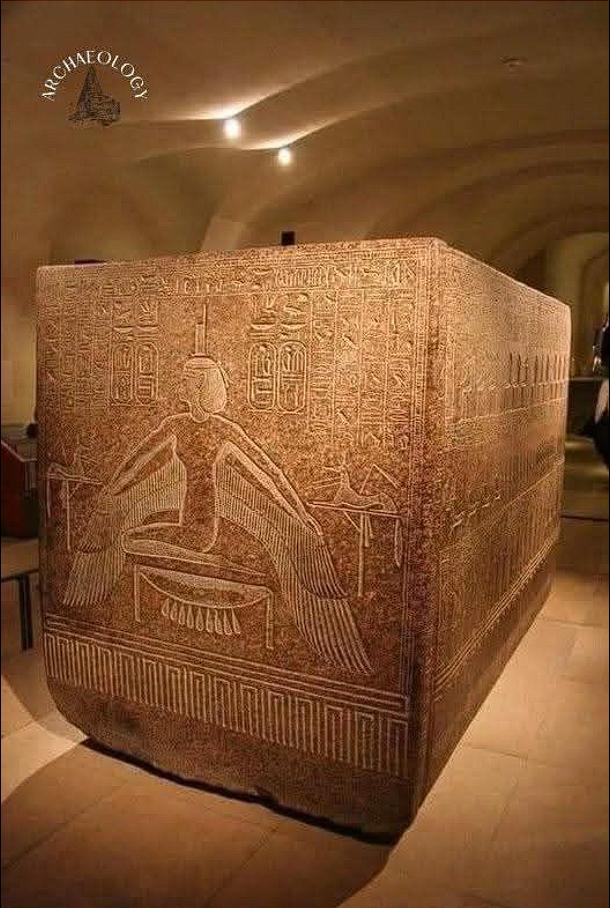“The monumental sarcophagus of Ramesses III, a powerful pharaoh of the New Kingdom, stands as a testament to the grandeur and spiritual depth of ancient Egyptian civilization. Carved from red granite and adorned with intricate hieroglyphs, this seven-ton masterpiece, discovered in the Valley of the Kings, served not merely as a royal coffin but as a vessel for the pharaoh’s journey into the afterlife. It offers a profound glimpse into the ancient Egyptian vision of eternity and the divine power of kingship.”
A Royal Resting Place: Unveiling the Pharaoh’s Journey
- A Monument of Power:
- The sarcophagus of Ramesses III, carved from red granite and weighing over seven tons, is a powerful symbol of the pharaoh’s authority and the grandeur of his reign. Its sheer size and the intricate craftsmanship reflect the resources and skill dedicated to honoring a ruler who defended Egypt from foreign invasions and internal turmoil.
- This monumental piece was not simply a burial container but a declaration of Ramesses III’s divine status and his enduring legacy in the afterlife.
- Hieroglyphic Narratives:
- Covered in beautifully detailed hieroglyphs, the sarcophagus serves as a narrative in stone, telling the story of Ramesses III’s passage into the afterlife. These inscriptions, carefully chosen and meticulously carved, depict the pharaoh’s journey, his encounters with deities, and his transformation into a divine being.
- This hieroglyphic narrative provides invaluable insights into the ancient Egyptian beliefs about death, resurrection, and the afterlife, revealing the complex cosmology that guided their understanding of existence.
- Divine Protection:
- The lid of the sarcophagus features a carved image of Ramesses III, flanked by gods and symbols meant to ensure his safe passage to the underworld. These divine figures serve as protectors and guides, assisting the pharaoh in his journey through the perilous realms of the afterlife.
- This imagery underscores the pharaoh’s divine connection and his role as an intermediary between the earthly and divine realms, a crucial aspect of ancient Egyptian kingship.
The Valley of Kings: A Royal Necropolis and a Sacred Landscape
- A Legendary Burial Ground:
- Discovered in the Valley of the Kings, the legendary burial ground for Egypt’s pharaohs, the sarcophagus is part of a larger complex that includes Ramesses III’s tomb (KV11), one of the most elaborately decorated in the valley.
- This location, chosen for its seclusion and sanctity, reflects the ancient Egyptians’ meticulous preparations for the afterlife and their belief in the importance of preserving the pharaoh’s legacy.
- KV11: A Testament to Royal Splendor:
- Ramesses III’s tomb, KV11, is a testament to the pharaoh’s power and the artistic achievements of his reign. Its intricately decorated walls and corridors depict scenes from the pharaoh’s life, his military campaigns, and his journey through the underworld.
- This tomb, along with the sarcophagus, serves as a comprehensive narrative of the pharaoh’s life and afterlife, providing a rich tapestry of information about ancient Egyptian beliefs and practices.
- A Sacred Landscape:
- The Valley of the Kings, with its hidden tombs and elaborate decorations, was considered a sacred landscape, a place where the pharaohs would embark on their eternal journey. The sarcophagus of Ramesses III, placed within this sacred context, underscores its significance as a vessel for the pharaoh’s transformation.
- This landscape, imbued with spiritual meaning, reflects the ancient Egyptians’ deep connection to the afterlife and their belief in the continuity of existence beyond physical death.
A Timeless Expression: Divine Kingship and Eternal Vision
- Divine Kingship:
- The sarcophagus of Ramesses III is more than just a royal coffin; it is a timeless expression of divine kingship. Its intricate carvings and hieroglyphic inscriptions highlight the pharaoh’s role as a divine ruler, chosen by the gods to lead Egypt.
- This concept of divine kingship was central to ancient Egyptian civilization, shaping their political, religious, and social structures.
- Vision of Eternity:
- The sarcophagus also reflects the ancient Egyptian vision of eternity, a belief in the continuity of life beyond physical death. Its imagery and inscriptions portray the pharaoh’s journey through the underworld and his transformation into a divine being.
- This vision of eternity, deeply ingrained in Egyptian culture, influenced their funerary practices and their elaborate preparations for the afterlife.
- Enduring Legacy:
- The sarcophagus of Ramesses III, a masterpiece of ancient Egyptian art and craftsmanship, continues to captivate visitors and scholars alike. Its grandeur and symbolic significance serve as a reminder of the enduring legacy of a civilization that sought to conquer death and achieve immortality.
- Its preservation and study contribute to our understanding of ancient Egyptian beliefs and practices, bridging the gap between the past and the present.
Conclusion:
“The sarcophagus of Ramesses III, a monumental testament to ancient Egyptian artistry and spiritual beliefs, serves as a profound window into the pharaoh’s journey to eternity. Carved from red granite and adorned with intricate hieroglyphs, this seven-ton masterpiece, discovered in the Valley of the Kings, is more than just a royal coffin; it is a timeless expression of divine kingship and the ancient Egyptian vision of eternal life. Its grandeur and symbolic significance continue to resonate, reminding us of the enduring legacy of a civilization that sought to transcend the boundaries of mortality.”

CÁC TIN KHÁC
Mary Walton: The Forgotten Inventor Who Helped Clean Up America’s Cities
Tomb of Queen Nefertari in the Valley of the Queens, Egypt
Discover the Hypostyle Hall of the Temple of Hathor at Dendera
Venus de Losange: Unveiling the Mystery of a 20,000-Year-Old Paleolithic Icon